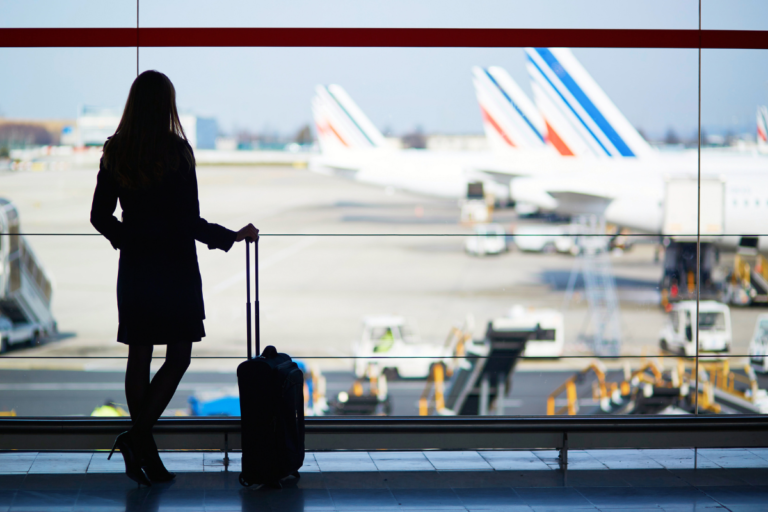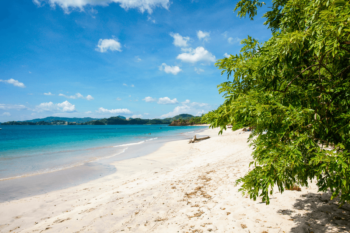Costa Rica Immigration: What's Covered
Clearing Costa Rica immigration takes 30 minutes to 3 hours depending on which airport you choose and when you arrive. You’ll need your passport valid for your entire stay, proof of onward travel within 180 days, and first-night accommodation details ready. San José (SJO) typically runs 2-3 hours during peak season while Liberia (LIR) moves faster at 30-90 minutes. Having a rental car pre-arranged gets you exploring immediately after clearing customs.
Quick Facts:
- Tourist visa: Most visitors receive 180 days automatically (changed from 90 days in 2023)
- Peak delays: December-April, especially Friday-Monday arrivals between 11am-2pm
- Customs uses green/red light system—most travelers get green and pass without inspection
- Always request passport stamp—rental companies need it to verify your legal driving period
- Best arrival times: Before 10am or after 6pm to avoid mid-day flight clusters
Top 4 Immigration Tips:
- Use Immigration Area Bathrooms – They’re air-conditioned with multiple stalls, unlike the single non-AC ones in baggage claim
- Exchange Minimal Cash at Airport – Hit Banco Nacional ATMs instead for better rates, exchange just $20-40 for immediate needs
- Screenshot All Documents – Keep offline copies of return flights and accommodation details on your phone for quick access
- Bring Your Own Pen – Immigration desk pens rarely work, and you’ll need one for customs forms if distributed
Your Costa Rica adventure starts the moment you clear those final doors—skip the taxi haggling and shuttle stops by having your vehicle ready for immediate exploration of nearby activities.
If you need any help with a Costa Rica car rental, contact us now!
Landing in Costa Rica and clearing immigration takes 30 minutes to 3 hours depending on when you arrive, which airport you choose, and whether it’s peak season. You’ll need your passport (valid for your entire stay), proof of onward travel within 180 days, and your accommodation details ready. The process is straightforward: immigration first, then baggage claim, then customs screening using a green/red light system where most travelers pass through without inspection. Both San José (SJO) and Liberia (LIR) airports follow identical procedures, though Liberia typically moves faster due to fewer simultaneous arrivals.
Key Takeaways
- Processing time: 30 minutes (low season at LIR) to 3+ hours (peak season at SJO)
- Required documents: Valid passport + proof of exit within 180 days + first night’s accommodation
- Tourist visa: Most visitors get 180 days automatically (was 90 days until 2023)
- Best strategy: Use immigration area bathrooms (they have AC), exchange minimal cash at airport
- Peak delays: December-April, especially Friday-Monday arrivals between 11am-2pm
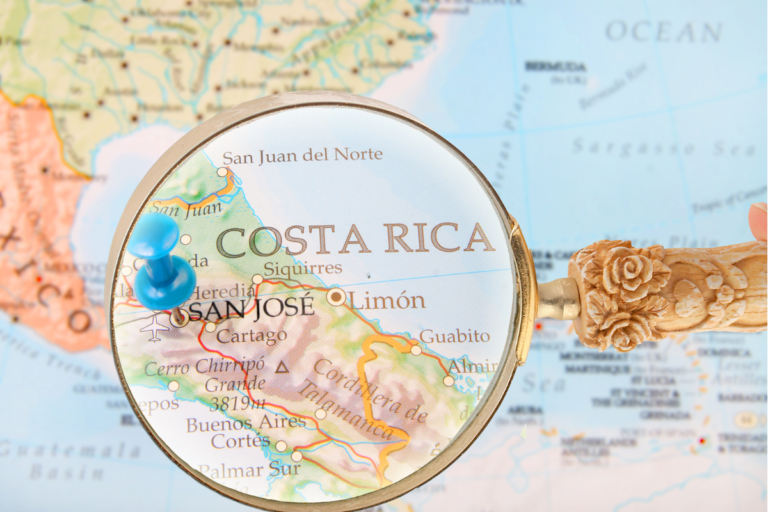
What Documents Do You Actually Need for Costa Rica Immigration?
Here’s exactly what immigration officers will ask for when you reach the desk – and yes, they’re getting stricter about checking everything:
Your passport needs to be valid for your entire stay. Not six months like other countries – just don’t let it expire while you’re here. Immigration scans it and checks the photo page against your face.
Proof of onward travel is non-negotiable now. This means showing a ticket leaving Costa Rica within 180 days. Screenshot your return flight confirmation on your phone or print it out. Bus tickets to Panama or Nicaragua work too if you’re continuing overland.
Your first accommodation details matter. Have your hotel name, Airbnb address, or wherever you’re staying that first night. They want the actual location – “somewhere in Tamarindo” won’t cut it. Write it down or save it in your phone notes.
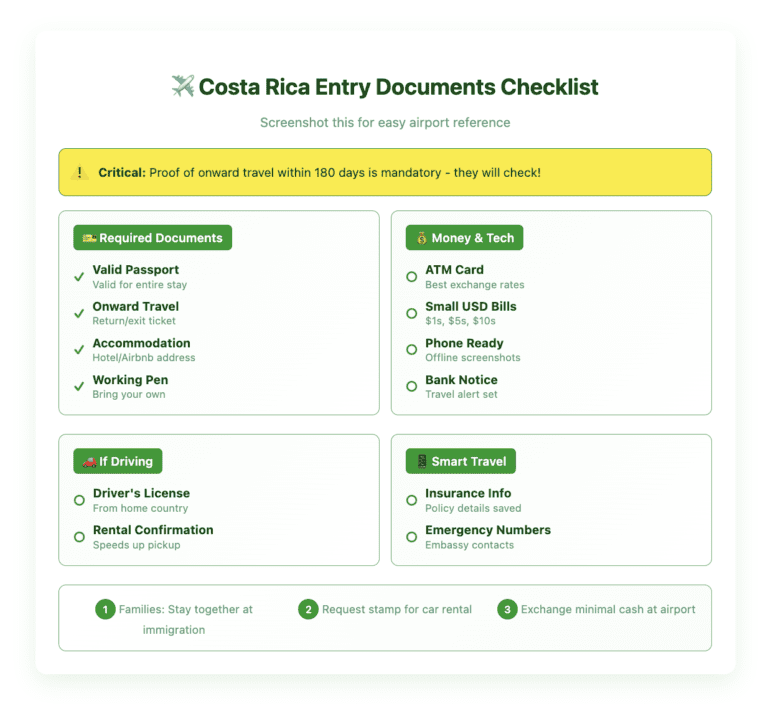
What About the Customs Form?
Airlines sometimes hand out customs forms on the plane, sometimes they don’t. Either way, you’ll need this info ready:
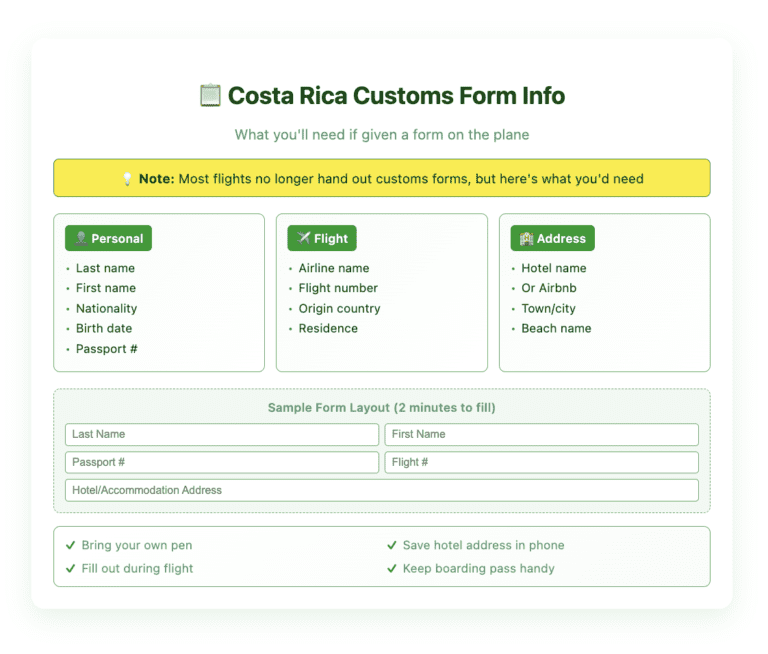
The form takes 2 minutes to fill out. Pro tip: the pens at immigration desks usually don’t work, so bring your own.
How Long Does Immigration Really Take at Each Airport?
What’s the Wait Time at San José Airport (SJO)?
SJO handles way more flights than Liberia, which means longer lines when multiple planes land together. During the low season (September-November), you might breeze through in 45 minutes. But February? When three flights from Houston, Miami, and Newark all arrive at once? Budget 2-3 hours minimum.
The sweet spot for arrivals is before 10am or after 6pm. Those mid-day arrival clusters between 11am and 2pm create the worst bottlenecks, especially on Saturdays.
What About Liberia Airport (LIR)?
Liberia moves faster – usually 30 minutes to an hour max. The airport’s smaller, fewer flights arrive simultaneously, and immigration has enough booths for the traffic. Even during peak season, you’re rarely looking at more than 90 minutes total.
That said, Thursdays and Sundays during high season can get backed up when charter flights arrive alongside scheduled ones. Still beats SJO’s crowds though.
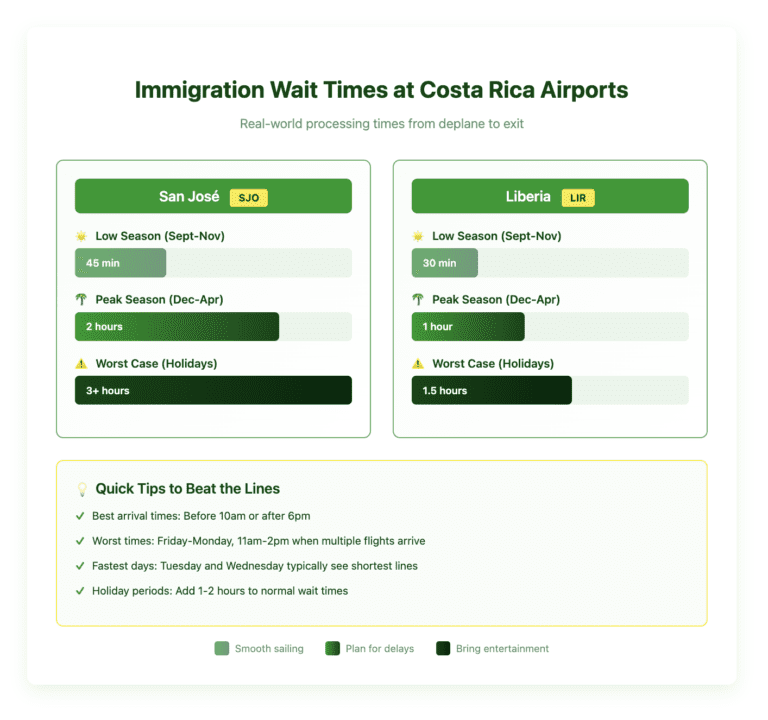
What Actually Happens Step-by-Step?
Where Do You Go After Getting Off the Plane?
Follow the “Migración” signs – you can’t miss them. At both airports, you’ll walk through a corridor (SJO’s is longer) to reach immigration hall. Families stay together and approach the booth as a group. Couples and friends typically go separately unless you’re married.
Here’s an insider tip: those bathrooms in the immigration area? They’re air-conditioned and have multiple stalls. Use them. The ones in baggage claim aren’t air-conditioned, and there are only two individual ones. Trust me on this.
What Questions Will Immigration Officers Ask?
The officers speak English and keep it simple:
- How long are you staying?
- Where are you staying?
- Is this your first time in Costa Rica?
- What’s the purpose of your visit?
Answer clearly, have your documents ready, and you’re through in under a minute per person. They’ll stamp your passport with your permitted stay length – usually the full 180 days if you showed proof of exit within that timeframe.
Critical detail: Request that passport stamp even if they don’t offer. Rental car companies need to see it, and you can only legally drive in Costa Rica for the duration of your stamped tourist visa.
How Does the Baggage and Customs Process Work?
After immigration, you’ll enter baggage claim through double doors. Find your carousel (there aren’t many), grab a free cart if needed, and collect your bags.
Then comes customs screening – everyone puts their bags through the X-ray scanner. Yes, even carry-ons. After scanning, you’ll either get a green light (go ahead) or red light (inspection required). It’s random, though unusual items like multiple electronics or commercial quantities of anything might trigger a check.
Once cleared, you exit through one-way doors marked “no re-entry” and boom – you’re officially in Costa Rica.

What Services Are Available After You Clear Customs?
Which ATMs and Money Exchange Should You Use?
Skip the airport exchange counters – they’re convenient but offer terrible rates. Instead, hit the Banco Nacional or BAC ATMs in the arrival hall. They dispense colones at decent rates and accept most international cards.
Need some immediate cash for tips or a taxi? Exchange just $20-40 at the airport counter to tide you over, then find a bank in town the next day for better rates. Supermarkets also accept dollars and give change in colones at fair rates.
Where Can You Get a Local SIM Card?
Kolbi, Movistar, and Claro all have counters in both airports’ arrival areas. A tourist SIM with data runs $10-30 depending on how much data you want. Kolbi has the best coverage in remote areas, Claro is fastest in cities. The staff will set it up for you right there – takes 5 minutes.
When Should You Arrive for Departure?
How Early for International Flights?
Get to the airport 3 hours before international departures. Yes, really. Security got stricter, check-in lines got long, and if you’re returning a rental car, add another 30 minutes for that process.
From San José, add extra time if you’re driving through the city during rush hour (6:30-8:30am or 4-7pm). That normally 20-minute drive can take an hour when traffic’s bad.
What About Domestic Connections?
For domestic flights to places like Quepos or Drake Bay, arrive 90 minutes early. The domestic terminal at SJO is separate – about a 5-minute walk from the main terminal. Factor this in if you’re connecting from an international arrival.
How Do Peak Travel Times Impact the Immigration Process?
Which Dates See the Worst Crowds?
Brutal honesty? These periods are immigration nightmares:
- December 20 – January 5 (Christmas/New Year)
- The week before and after Easter
- U.S. Spring Break (mid-March)
- July – early August (summer vacations)
During these times, even Liberia can see 2-hour waits, and SJO becomes a patience-testing marathon.
What Days and Times Move Fastest?
Tuesday and Wednesday arrivals typically see the shortest lines. Early morning flights (arriving before 10am) or red-eyes (arriving after 10pm) also move quicker.
September through early November is the sweet spot – fewer tourists, no holiday rushes, and immigration is often under 30 minutes at either airport.
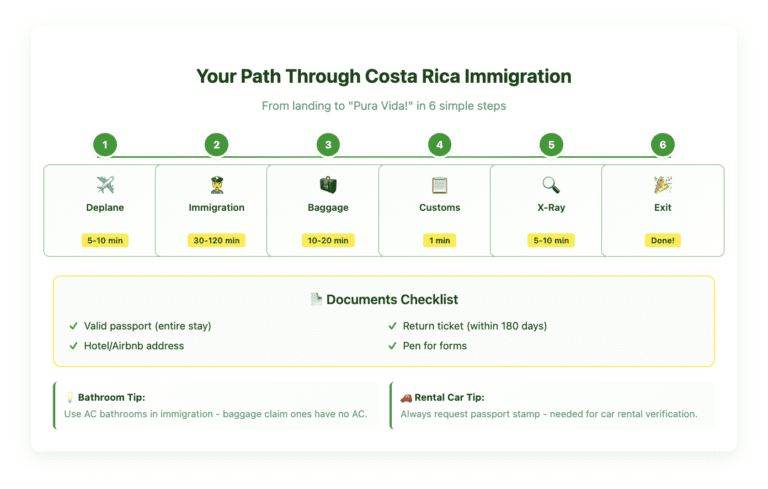
What Are Common Immigration Hiccups and Solutions?
What If You Don’t Have Proof of Onward Travel?
Immigration won’t let you enter without it. Period. If you honestly forgot to print it, you can:
- Buy a refundable ticket on your phone while in line
- Purchase a bus ticket to Panama or Nicaragua online ($30-40)
- Show proof of a rental car booking that extends beyond your stay
Don’t try talking your way through without it – they’ve heard every excuse.
What Happens If Your Passport Expires During Your Stay?
You won’t be allowed entry. Immigration checks this carefully now. If your passport expires even one day before you leave Costa Rica, they’ll deny entry. No exceptions.
Ready to Breeze Through Costa Rica Arrivals?
Immigration at Costa Rica’s airports is straightforward when you know what to expect. Have your documents ready, pick your arrival time strategically if possible, and remember those AC bathrooms in immigration. Most importantly, that proof of onward travel isn’t optional anymore – have it ready.
Once you clear customs and walk through those final doors, the real adventure begins. Having a rental car waiting makes that transition from airport to exploration seamless – no haggling with taxis, no waiting for shuttles that stop at six hotels before yours.
Next steps: Screenshot your return ticket now. Save your first night’s accommodation address in your phone. Bring a pen. And if you’re flying into SJO during peak season, maybe download a good podcast for that immigration line.
Need reliable wheels waiting when you land? Contact Vamos Rent-A-Car to arrange your airport pickup. With offices at both SJO and Liberia airports, you’ll be on the road exploring within minutes of clearing customs – because the best parts of Costa Rica aren’t in the airport.
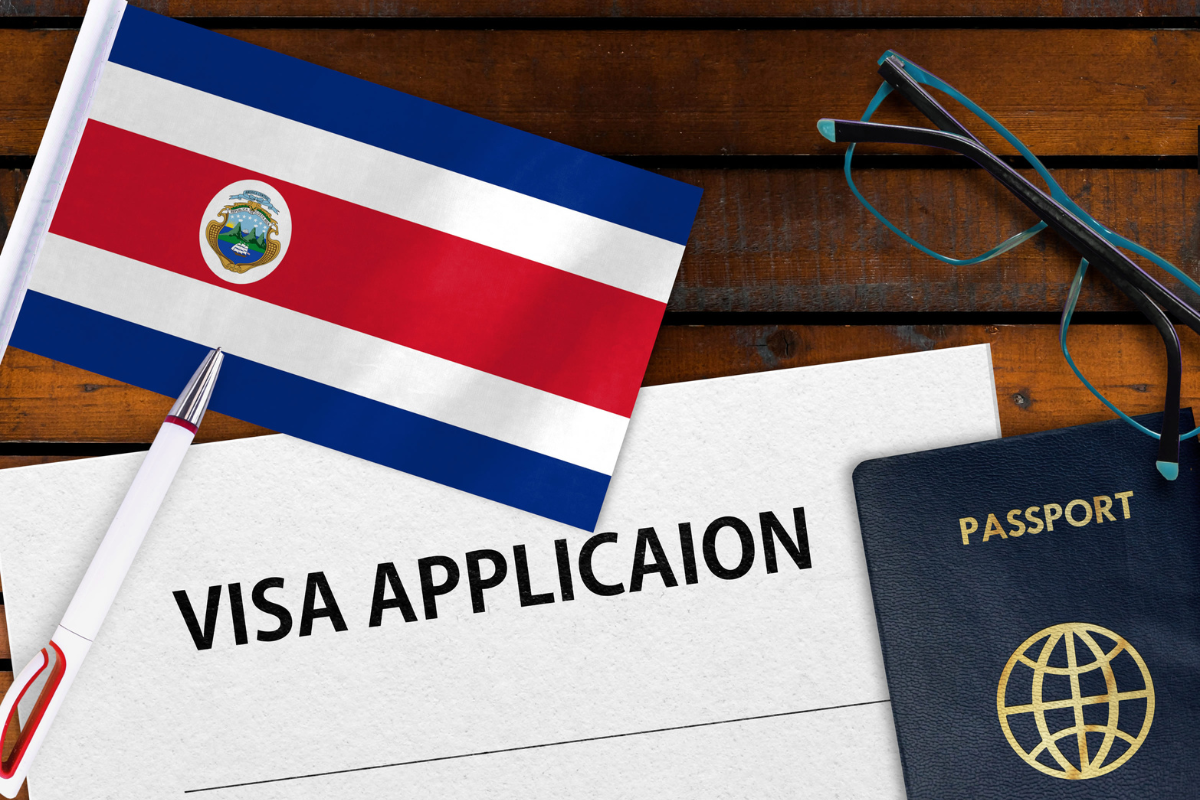
Frequently Asked Questions
How long does it take to get through customs at SJO?
The entire process from landing to exit at San José Airport typically takes 45 minutes to 3 hours. During the low season (September-November), you’re looking at about 45 minutes total. Peak season (December-April) expects 2 hours minimum, and during holidays like Christmas week, budget for 3+ hours. The actual customs screening itself is quick – maybe 5-10 minutes – but it’s the immigration lines before customs that eat up time. Pro tip: flights arriving before 10am or after 6pm move faster since you avoid the mid-day arrival clusters.
What do I need for customs in Costa Rica?
For customs specifically, you might need to fill out a declaration form (though many travelers don’t get one anymore). Have your passport, flight info, and first night’s accommodation address ready. The actual customs process uses a random selection system – after collecting your bags, you put them through an X-ray scanner. Green light means go, red light means inspection. Most people get green. Don’t bring fresh fruits, vegetables, or meat products – they’ll be confiscated. Also, if you’re carrying over $10,000 USD in cash, you must declare it.
What can you not bring through customs in Costa Rica?
Costa Rica customs will confiscate: fresh fruits and vegetables, meat products (yes, even that airport sandwich), plants or seeds, dairy products, and honey. Medications should be in original containers with prescriptions. You can bring up to 5 liters of alcohol and 400 cigarettes duty-free. Electronics for personal use are fine, but multiple items of the same type might trigger questions about commercial importation. Coffee beans are allowed going out, not coming in (ironically). Drones require special permits – don’t bring one without checking current regulations first.
How early should I get to San Jose Costa Rica airport for an international flight?
Arrive 3 hours before your international flight – no exceptions. SJO has gotten stricter with security procedures, and check-in lines can be brutal. If you’re returning a rental car, add another 30-45 minutes for that process. Coming from downtown San José? Factor in traffic – that 20-minute drive becomes an hour during rush hour (6:30-8:30am or 4-7pm). Set your GPS for “Juan Santamaría Airport” not “San José Airport” to avoid confusion. Having your rental car return handled smoothly makes a huge difference in departure stress levels.
Does Costa Rica stamp your passport?
Yes, immigration officers stamp your passport with your entry date and permitted stay length (usually 180 days for US, Canadian, and EU citizens). Here’s the thing – always request that stamp even if they don’t automatically do it. Why? Rental car companies need to verify your legal status and driving permission duration. You can only legally drive in Costa Rica for the length of your stamped tourist visa. No stamp could mean hassles picking up your rental car or during police checkpoints.
What to expect when arriving at Liberia Airport?
Liberia Airport (LIR) is smaller and typically faster than San José – expect 30 minutes to 1 hour total processing time. You’ll deplane onto the tarmac (sometimes) or via a jetbridge, then walk to immigration. The immigration area is air-conditioned, but smaller than SJO with fewer booths. After getting your passport stamped, you’ll grab bags from one of two carousels, then put everything through the customs X-ray. The airport exit leads directly into the terminal where rental car desks are immediately visible. The whole airport is more compact and easier to navigate than SJO.
Do US citizens need a visa for Costa Rica?
US citizens don’t need a visa for tourist stays up to 180 days (extended from 90 days in 2023). You just need a passport valid for your entire stay and proof of onward travel within those 180 days. That onward travel proof is non-negotiable now – have your return flight confirmation ready to show. The 180-day allowance is at the immigration officer’s discretion, though most US citizens get the full period if they show appropriate exit tickets.
What is the first thing to do after arriving at the airport?
After clearing customs and exiting through those one-way doors, your priorities are: 1) Hit the ATM for colones (Banco Nacional or BAC have the best rates), 2) Get a local SIM card if you want data for navigation – Kolbi has the best coverage in remote areas, 3) Grab a coffee at the airport café to celebrate your arrival, then 4) Head to your pre-arranged transportation. If you’ve pre-booked a rental car, head straight to the rental desk – having everything arranged in advance means you’ll be on the road exploring within 30 minutes instead of waiting in lines.
